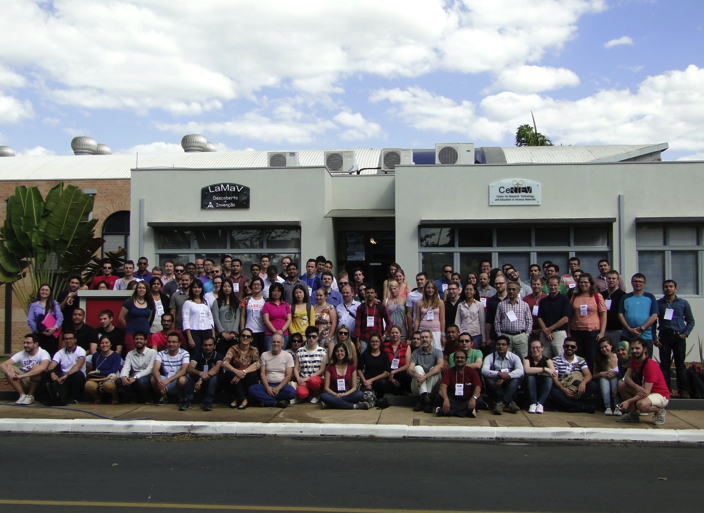
[Image above] Students and lecturers from the São Paulo Advanced School on Glasses and Glass-Ceramics in front of the Laboratory of Vitreous Materials at the Federal University of São Carlos in Brazil. Credit: Edgar Zanotto
[Editor’s note: This update comes to us from CeRTEV members Karina Lupetti, Ana C.M. Rodrigues, Eduardo B. Ferreira, Hellmut Eckert, and Edgar D. Zanotto.]
By Karina Lupetti, Ana C.M. Rodrigues, Eduardo B. Ferreira, Hellmut Eckert, and Edgar D. Zanotto
The São Carlos Center of Research, Technology and Education in Vitreous Materials (CeRTEV) conducts state-of-the art research, develops technology, and supports education and outreach efforts focused on glass and glass-ceramics. This 11-year, approximately $22 million effort has funding of about $2 million per year through 2018, after which the São Paulo State Research Foundation (FAPESP) will evaluate the program before authorizing funding for the following six years.
In a Ceramic Tech Today article from 2013, the Center’s director, Prof. Edgar D. Zanotto, said “We believe this will give us some momentum… We expect the project will catalyze some energy, some new efforts, and perhaps motivate some young people to enter the field. Let’s talk in three years and see how things are going. At least for Brazil, it will likely have a large impact. As to the international glass science, let’s see. I hope so!”
Four years have passed since then. With 14 professors at the Federal University of São Carlos (UFSCar), the University of São Paulo (USP), and the São Paulo State University (UNESP) and 60 students and post-docs, CeRTEV remains one of the largest academic units devoted to the subject of glass and glass ceramics on this planet. Its mission is to conduct state-of-the art research, technology development, and education and outreach, aiming to include and keep Brazil among the top 12 glass research countries in the world.
As part of the joint CeRTEV research agenda, the center’s 14 faculty work together to develop new glasses, glass-ceramics, composites, and hybrid materials, presenting relevant functionalities—such as high mechanical strength, electrical conductivity, biological, optical or catalytic activity, and/or combinations of these properties—guided to different applications. CeRTEV’s scientific, technological and educational progress is being monitored by an International Advisory Board (IAB) consisting of 22 international leaders in glass science and industry. Valuable recommendations from the IAB have been added regularly to our agenda, and many board members have also become scientific collaborators in the meantime.
CeRTEV’s research programa is divided into five core areas, dedicated to the principal fields of glass and glass-ceramic applications:
- Structural materials for architecture, construction, armor, and dental restoration;
- Bioactive glasses and glass-ceramics for bone and cartilage healing and growth;
- Ion-conducting materials for applications in modern battery and energy technologies;
- Photonic glasses and glass-ceramics; and
- Catalytically active systems.
All these application areas benefit from fundamental research encompassing development of fundamental concepts regarding the structural description of glasses and structural, dynamic (diffusion, relaxation, and viscous flow), and mechanistic aspects of processes involved in the crystallization of glasses leading to glass-ceramics. A short scientific report highlighting special recent accomplishments is avaiable here.
On the technology side, CeRTEV activities are channeled towards generation of new technologies and patents, all the way to new products and manufacturing processes—a “science to business approach.” Thus far, new or improved patentable glass or glass-ceramic materials have been developed for light armors (for use in airplanes and cars and by individuals), solid electrolytes for electrochemical devices, tougher monolithic glass-ceramics for dental restoration, macroporous and hierarchically ordered scaffolds, fibers, small monolithic parts, and powders with increased osteoinductive activities combined with the ability for targeted drug delivery for bone and tissue repair.
CeRTEV’s education and outreach strategies focus on development of long-term sustainability of glass science and technology in Brazil. The goal is to attract more professionals, students, teachers, and scientists to this important research and technology sector. At present, a lack of training courses dedicated to professionals in the glass industry seriously impinges its development.

CeRTEVs scientific outreach activities are directed towards: (1) the science community, through conferences, workshops, and the School on Glass; (2) the glass industry, through a technical course on glass technology; (3) schools, through activities for the integration of education, research, and extension; and (4) the general public, through science dissemination in community educational events.
Together with the Brazilian Association of Automated Glass Industries (ABIVIDRO) and the Paula Souza Center, the São Paulo state government office, we have developed a full curriculum for a three-semester glass technology course. The course consists of 450 hours of theoretical classes on glass formulation, physical processes, energy management, workplace and environmental safety, and entrepeneurship and 850 hours of practical training. The course will be taught in the city of Mogi das Cruzes (70 km from São Paulo), which holds one of the Paula Souza Technical Schools and is also the site of important Brazilian glass industries.
In parallel, we have mounted an aggressive public promotion and education effort on glass and glass-ceramics. Our activities include development of educational kits, mutual visitation projects with high schools, participation in science fairs, design of visually attractive display banners and science comics, as well as theater presentations that we call “science on stage.”
Altogether, the first four years have been exciting, challenging, and productive. We have consolidated a coherent collaborative research, technology, and education program dealing with fundamental research and development of new materials with technologically interesting properties. Based on this three-pronged strategy, we hope to make more substantial contributions in the future to ensure sustained growth of the glass and glass-ceramic technology sectors in Brazil in the seven years to come!
Head over to the ACerS Glass and Optical Materials Division website to read the entire report on the accomplishments, activities, and future directions of CeRTEV.
CeRTEV has been supported by the São Paulo Research Foundation, FAPESP, process no. 2013-07793-6 (CEPID program) for 5 years, with an additional 6 years of funding pending.
